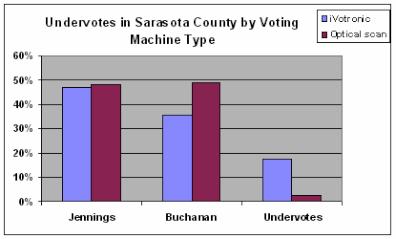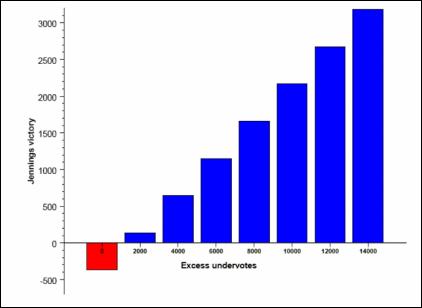Powerful Arguments Presented to Void Florida Congressional Election
Notice of Contest: Christine Jennings, Contestant United States House of Representatives
Michael Collins
“Scoop” Independent New
First in a Series
Washington, DC
On December 20, 2006, Democratic candidate for Congress Christine Jennings filed a Notice of Contest Regarding the Election in Florida’s 13th Congressional district. Jennings trailed Republican Vern Buchanan by 369 votes at the close of voting. There was one glaring problem. The announced results showed that there were 18,412 undervotes in Sarasota County, the heart of the district and also Jennings stronghold of support. Attorney Coffey defines an undervote as ballot lack lacks a mark for one race while others are marked.
The 18 thousand voters who showed no selection for the congressional race represent 14.9% of voters of Sarasota County voters for this election election. Florida undervoting is typically at or below 2.5%, a marked difference from election day 2006 results in Sarasota.
Even by the standards of Florida elections, this result was strange and disturbing. There were protests and excuses explanations almost immediately. Then Jennings Campaign cried foul:
 “There
is a real crisis in confidence among voters, not just in
Florida but throughout the country. The voters of District
13 deserve answers, but this case has much wider
implications beyond Florida. This is a test case for the
entire nation.” Christine Jennings, (picture left) 30 Nov.
2006
“There
is a real crisis in confidence among voters, not just in
Florida but throughout the country. The voters of District
13 deserve answers, but this case has much wider
implications beyond Florida. This is a test case for the
entire nation.” Christine Jennings, (picture left) 30 Nov.
2006
The Buchanan campaign immediately dismissed Jennings complaints. They continue to do so in vigorous terms. “Undeterred by the facts and despite some good advice from even the most strident Democrats who cautioned against challenging the election in the U.S. House, Christine Jennings has now filed a baseless notice of contest that will potentially cost taxpayers millions of dollars on top of what is already being spent on litigation. The Buchanan Campaign, 20 Dec. 2006
The Election Contest
Federal election law provides for challenges to elections when serious questions arise concerning elections - Federal Contested Election Act (P.L. 91-138, 83 Stat. 284). Election contests have declined considerably since the 1930’s but they remain part of the rules and procedures of the U. S. House of Representatives. Just two months before this election, then House Democratic Whip Steny Hoyer of Maryland urged the House Committee on Administration to clarify and clean up election contest. Hoyer anticipated a number of very tight races and noted problems with the law and procedures. His suggestions were dismissed by the Republican controlled committee. House procedures and precedents will be considered in Part 2 of this series.
Core Arguments Presented in the Jennings Challenge
The election contest was filed with noted Miami attorney Kendall Coffey as lead counsel. His web site notes that he specializes in high stakes and high profile cases. He represented Al Gore in the 2000 Florida recount and before that, Cuban child refugee Elian Gonzalez.
The Jennings
case as presented relies on four key
arguments.
(1) The evidence available from voting in the 13th district and other parts of the state plus the known security vulnerabilities of the ES&S iVotronic touch screen voting machine show that there is “no possibility” that 14.9% of the voters in Sarasota County intentionally withheld votes.
(2) The evidence gathered by extensive voter testimonials demonstrates that there were significant numbers of voters who wished to vote for candidate Jennings but encountered problems with the iVotronic touch screen voting machine.
(3) There is a strong correlation between the date iVotronic touch screens were prepared for voting and incidents of undervoting.
(4) Statistical analysis shows that incremental reductions of in undervotes would result in a Jennings victory beginning with just 2000 fewer undervotes
There are supporting points as well, including a discussion of the Jennings case in Florida Court to open up ES&S computer source code for examination
The conclusion drawn from the evidence is simple: the election should be held null and void, there should be a new election, and no one should be sworn in or seated in Congress until after the new election.

Sarasota County undervotes were six times higher than those in other counties in the 13th Congressional district. Sarasota County was Democrat Jennings’ strongest base of support.
Argument 1: Evidence from Sarasota and other counties shows that the undervotes in that county were from machine malfunction.
Coffey presents his most persuasive evidence immediately. He notes undervoting in Saratoga County is six times higher than surrounding counties. The surrounding counties have rates within expected ranges, while Saratoga is well above the expected rate of around 2.5%. In a remarkable move, Coffey then shows that within Saratoga County, there is a major difference in undervotes based on the type of voting machine used. iVotronic touch screen voting machines were used for early in person voting. The rate of undervoting was 17.6%. Optical scan readers and special paper ballots were used for early voting by mail. The undervote rate for these 22 thousand votes was “only 2.5%, which is consistent with historical norms and expectations.” (p. 8)
Thus, in the opening argument of the contest, Coffey compares Sarasota undervotes with surrounding counties and then within Sarasota County based on voting machine type. In both cases, the Sarasota iVotronic voting machines produce undervote totals six to seven times those normally expected. In research terms, both between group and within group comparisons support the Jennings arguments. This is quite an accomplishment given that Coffey is dealing with after-the-fact evidence.

Within Sarasota county, early voting results show iVotronic touch screen machines produced far more undervotes than optical scan ballot readers.
Anticipating a
challenge to his position, Coffee points out that
disaffection or disgust with negative campaigning, a
purported cause for undervoting, could not be the cause
since this was not reflected in other counties in the
congressional district. He also argues that the poor
ballot design argument advanced by some is not viable
either. In the famous 2000 butterfly ballot fiasco in Palm
Beach, a poorly designed ballot by popular agreement,
undervotes only totaled 1%. There is no precedent for this
level of undervoting as an election day phenomena.
The poor ballot design argument relies on what election defenders term as the confused voter argument. Were the 15% of the voters confused on election day by a ballot that had one of the hottest races in the state? Not so argues Coffey: voters were motivated to vote, the race was an obvious focus as they entered the polling booth, and while not perfect, the ballot clearly showed the contestants in the congressional race.
Of real interest, Coffey offers an explanation for the phenomenon. He claims that poor ballot design interacting with ES&S source code was the culprit that caused voting machines to malfunction. The configuration of the ballot, he asserts, probably triggered problems with the ESS computer source code that denied the voting rights of thousands for whom no vote was recorded. This is consistent with an analysis from Professor Dan Wallach of Rice University who suggests that ES&S voting machine source code problems prevent actual votes from registering, thus producing undervotes.
Argument 2: The evidence gathered by extensive voter testimonials demonstrates that there were significant numbers of voters who wished to vote for candidate Jennings but encountered problems with the iVotronic touch screen voting machine.
The totally unexpected and unprecedented undervoting found only in Sarasota County is further explained as a machine problem by voter testimonials presented in the election contest brief.
There was no warning or mention of any problems however, I was aware there may be a problem with the Congressional vote based on various media reports. I went through the ballot and specifically remember voting for Christine Jennings. When I arrived at the review screen, there was no candidate selected for the Congressional vote. I called a poll worker over and explained the situation and she told me that I did not “press hard enough” when selecting the vote (p. 14)
This voter report covers a number of points that appear through out the citizen testimonials. The voter heard about voting problems with the touch screens in Sarasota County and took care to cast a ballot for Jennings. When receiving assistance, the voter was then informed about the need to press hard in order for the vote to count.
When I got to the review page, my vote for Christine Jennings was not reflected. I called out to a poll worker to alert them that my vote…had not been recorded. The poll worker who came to assist me informed me that the same thing had happened to her when she voted earlier. (p. 15)
In these and other voter reports included in the brief, the same pattern occurs again and again. Voters intended to and did vote for Jennings only to find out at the review screen that no vote was marked.
After describing the same type of problems and the difficulties voting for Jennings, one voter said “I am registered Republican and I believe these machines failed democracy.”
 Kendall Coffey
Kendall Coffey
Evidence was gathered from the
Sarasota County Supervisor of Elections office in the form
of incident reports and other documentation. Coffey found
that county officials were aware of clear problems with the
iVotronic machines well in advance of the election. Despite
the foreknowledge of problems; the county did nothing to
correct the problems.
Argument 3: There is a strong correlation between the date iVotronic touch screens were prepared for voting and incidents of undervoting.
Professor Stewart of MIT provides analysis found a possible explanation for the machine malfunction.
The machines prepared in the final days before the deadline for completing all such preparations exhibited the highest congressional undervote rates. Another strong correlation exists between the number of machines “cleared and tested on a given date and the undervote rate: “As the county’s staff or consultants got busier clearing and testing more machines on a singled day, the Congressional undervoting rate climbed.” The graph (p. 23) shows that on September 19, October 2, and October 5, 2006 only one machine was cleared and tested a day. Those machines had a 7% undervote rate. On October 17, 2006, 158 machines were cleared and tested. That group produced election day undervote rates of 21%.
Argument 4: Statistical analysis shows that incremental reductions of undervoting would result in a Jennings victory beginning with just 2000 less undervotes
The contest brief then goes on to present remarkable evidence supporting the claim that had the touch screen machines worked, Jennings would have been the clear winner
To support the Jennings victory hypothesis, he uses additional analysis by Professor Stewart, a proponent of electronic voting. The MIT political scientist analyzed the race and developed a formula that demonstrates a relationship between excess undervotes (any number above 3%) and their impact on the election.

This chart developed by Charles Steward, PhD, MIT shows the relationship between reduced undervotes due to machine error and a Jennings victory margin. With just 2000 fewer undervotes, Jennings would have won by 100 or so votes. As excess undervotes are eliminated, the Jennings victory margin increases. The final bar at the right represents the actual number of excess undervotes. Jennings would have won by 3000 votes in this scenario. Stewart’s calculations evaluated ballots based on the pattern of voter selections to determine the likely vote – Democrat or Republican (p. 25).
The Case So Far
At this point, Jennings has two cases critical to her success. She is suing ES&S in Florida Court to force production of the computer source code for the iVotronic voting machines in Sarasota County. The court has heard but not yet ruled on her request. Success there will bolster her case before the U.S. House of Representatives. Failure will no stop her case however. Even without a smoking gun in the form of inadequate source code, there is more than enough evidence that the majority of undervotes were due to machine malfunction. Even the most adamant coincidence theorist would have to admit that. Since the voters intended to vote but were denied that right, it is argued, the election should be declared void and a new one held.
This case presents an interesting political question. Who will be seated for this race? Speaker Nancy Pelosi indicated that she has not decided yet, which is very bad news for Buchanan who is already inviting people to his induction ceremony. A recent California ruling asserted the Speaker’s nearly an absolute right to swear in whomever he or she thinks is the winner of a race.
Here is one question nobody is asking. Who created the problem and why? Are we hearing testimonials or seeing statistical analysis showing that the undervotes had a negative impact on the Buchanan campaign? How many close races have there been over the past six years involving voting machine malfunction where a Democrat wins by small margins? Was the 2005 Paul Hackett, Dem. - Jean Schmidt, Rep. special election in Ohio’s 2nd Congressional district the prototype for subsequent photo finishes?
Computers do not produce consistent errors by accident. When consistent actions are performed by a computer controlled device, that device is programmed to take those actions. Further investigation may reveal that rather than a malfunction, the undervotes were an intended function of these voting machines. That would be a most interesting outcome if the Florida court puts ES&S in a position to fully reveal its software and methods.
© Copyright. Please feel free to reproduce
and distribute this in any fashion you feel suitable with an
attribution of authorship and the publisher, "Scoop"
Independent News, plus a link to the
article.


 Richard S. Ehrlich: Deadly Border Feud Between Thailand & Cambodia
Richard S. Ehrlich: Deadly Border Feud Between Thailand & Cambodia Gordon Campbell: On Free Speech And Anti-Semitism
Gordon Campbell: On Free Speech And Anti-Semitism Ian Powell: The Disgrace Of The Hospice Care Funding Scandal
Ian Powell: The Disgrace Of The Hospice Care Funding Scandal Binoy Kampmark: Catching Israel Out - Gaza And The Madleen “Selfie” Protest
Binoy Kampmark: Catching Israel Out - Gaza And The Madleen “Selfie” Protest Ramzy Baroud: Gaza's 'Humanitarian' Façade - A Deceptive Ploy Unravels
Ramzy Baroud: Gaza's 'Humanitarian' Façade - A Deceptive Ploy Unravels Keith Rankin: Remembering New Zealand's Missing Tragedy
Keith Rankin: Remembering New Zealand's Missing Tragedy